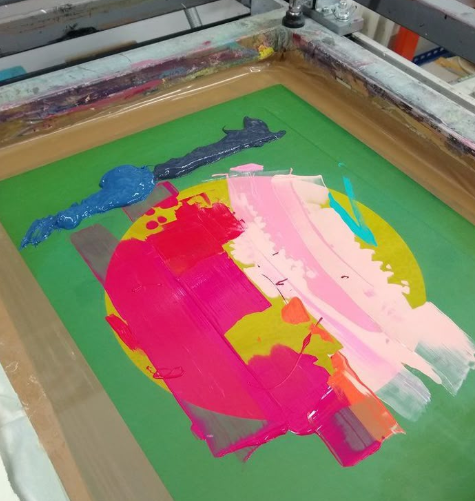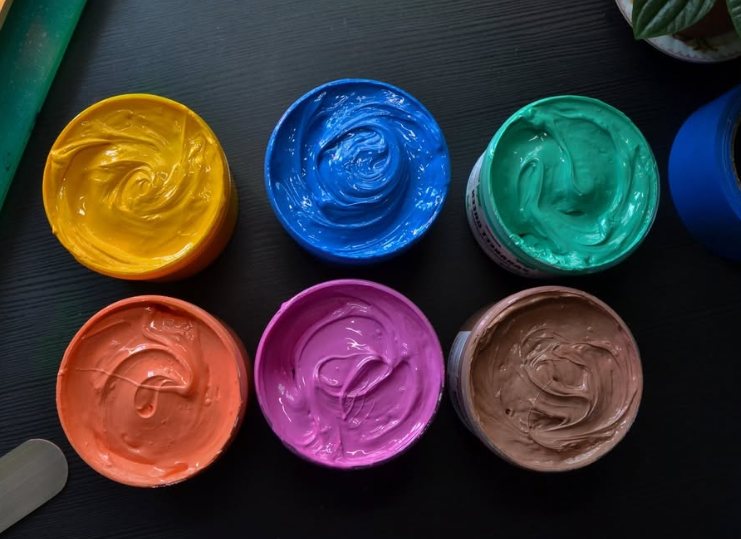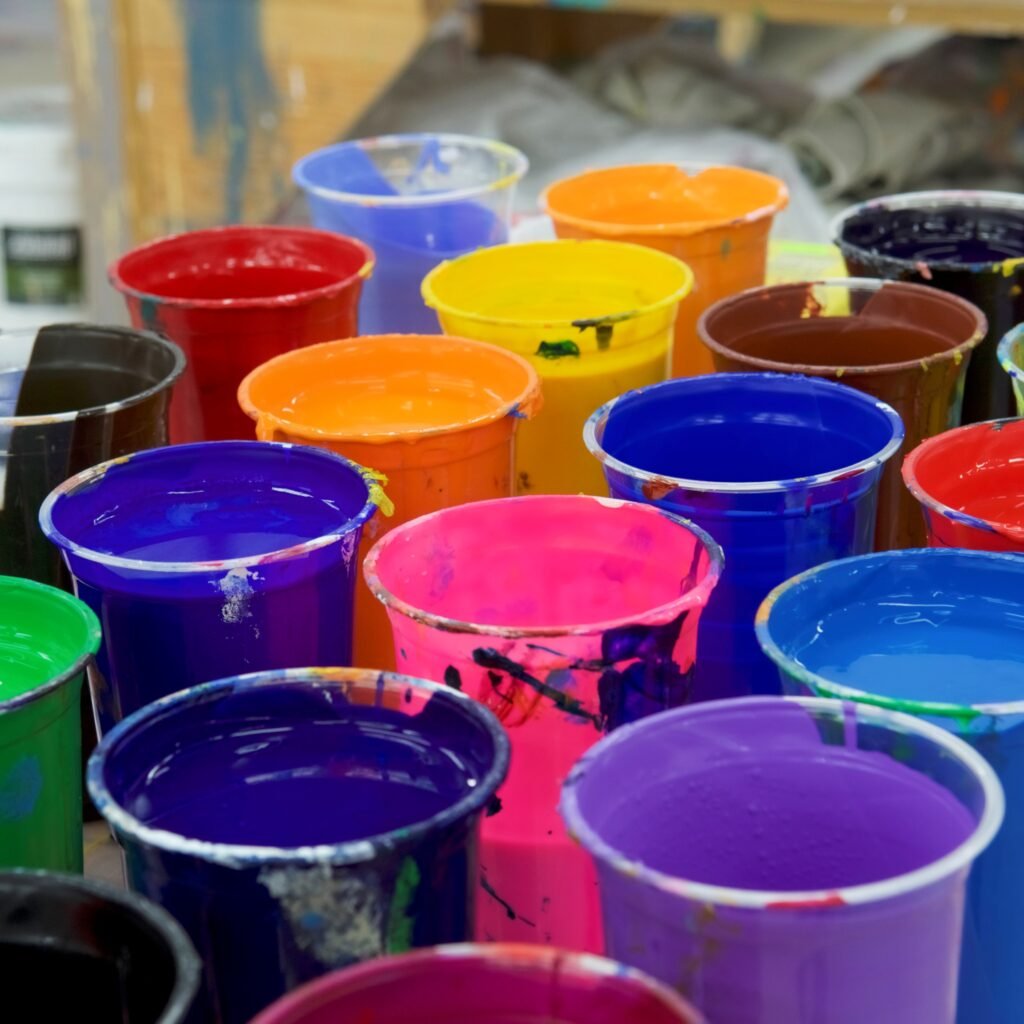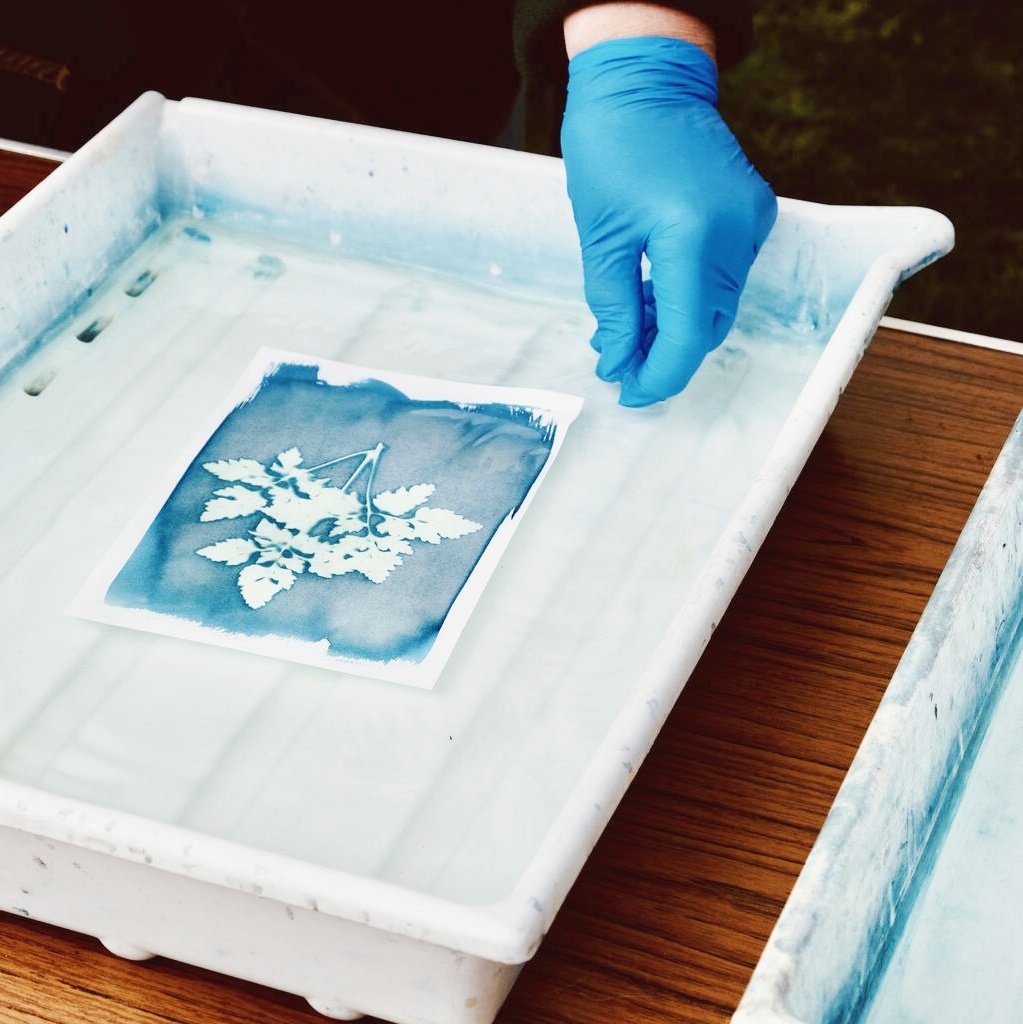Spis treści
Zrozumienie farb do sitodruku: rodzaje, wskazówki i techniki
Farby do sitodruku są zabawa oraz ważny. Sprawiają, że nasza sztuka jest jasna i wyrazista. W tym artykule poznamy farby do sitodruku. Porozmawiamy o… typy, porady, I technikiUżyjemy tabeli i list. Użyjemy też prostych słów, aby tekst był łatwy do odczytania dla każdego[^1].
Czym są farby sitodrukowe?
Farby do sitodruku są Wybierz specjalne kolory tuszu do druku blokowego, aby uzyskać niepowtarzalne wzory.. Trafiają na ekran, potem na koszulkę lub szyld. Tusz pokazuje naszą grafikę, więc wygląda Ładny oraz FajnyRodzaj wybranego tuszu może zmienić wygląd i trwałość Twojej pracy. Zmienia również łatwość drukowania. Użycie odpowiedniego tuszu zapewni Ci jasny kolory i spraw, aby wydruki były trwalsze.
Rodzaje farb sitodrukowych
Istnieje wiele rodzajów tuszu. Każdy ma swoje zalety oraz wadyOto główne typy:
1. Tusze plastizolowe
- Zalety:
- Mocny oraz wibrujący zabarwienie.
- Łatwe dla nowicjusze.
- Wytrzymały na wielu tkaninach.
- Wady:
- Potrzebują ciepła, żeby wyschnąć.
- Mają PCV.
Najlepiej dla:
- Koszulki i projekty o wysokim stopniu krycia.
- Wiele sklepów używa tych tuszy, ponieważ są popularny[^2].
2. Tusze na bazie wody
- Zalety:
- Więcej przyjazny dla środowiska.
- Oni dają miękki Patrzeć.
- Rozprzestrzeniają się w tkaninie.
- Wady:
- Szybko schną.
- Wymagają większych umiejętności.
Najlepiej dla:
- Zrównoważony druk i lekkie tkaniny.
- Ludzie dbający o środowisko uwielbiają te tusze[^3].
3. Tusze wyładowcze
- Te tusze usunąć kolor w ciemnych tkaninach.
- Oni dają klasyczny Patrzeć.
- Najlepiej dla:
- Wzory na bawełnie o staroświeckim charakterze.
4. Tusze specjalistyczne
Istnieje wiele fajnych, specjalnych tuszy:
- Tusze utwardzane promieniami UV:
- Szybko schną pod wpływem promieniowania UV.
- Zużywają mniej energii.
- Tusze Puff:
- Dostawać podpuchnięte gdy są podgrzane.
- Dają wrażenie trójwymiarowości.
- Tusze metaliczne / świecące w ciemności:
- Dodają wyjątkowej jakości nadrukom na odzieży. blask lub blask do wydruków.
Te tusze mogą ułatwić Twoją pracę wyróżniać się o niepowtarzalnym wyglądzie.

Jak wybrać odpowiedni tusz
Wybór odpowiedniego tuszu jest ważny. Oto kilka sposobów na wybór najlepszego tuszu:
- Rodzaj tkaniny:
- Do bawełny, poliestru i mieszanek potrzebne są inne tusze.
- Skończyć:
- Chcesz? lśniący spójrz, a matowy wygląd, albo teksturowany skończyć?
- Wpływ na klimat:
- Jeśli kochasz naszą planetę, wybieraj tusze niezawierające PVC i rozpuszczalników.
- Sprzęt:
- Czy posiadasz prasę termotransferową, suszarkę lub lampę UV?
Wskazówki dotyczące stosowania farby sitodrukowej
Aby uzyskać świetne wydruki, postępuj zgodnie z poniższymi wskazówkami:
1. Przygotowanie do druku
- Wyczyść ekran.
- Usuń kurz i stary tusz.
- Pokryć emulsją.
- Dzięki temu możesz stworzyć przejrzysty projekt.
- Wydruk testowy.
- Przed wykonaniem dużego wydruku wykonaj mały test.
2. Mieszanie i konsystencja tuszu
- Dokładnie wymieszaj tusz.
- Dobre wymieszanie daje gładką farbę.
- Kontroluj lepkość**
- W razie potrzeby należy zastosować reduktory lub opóźniacze.

3. Techniki ściągaczki
- Trzymaj ściągaczkę pod odpowiednim kątem.
- Używać odpowiednie ciśnienie dla gładkiego tuszu.
- Praktyka nacisk ściągaczki aby uzyskać schludny wydruk.
4. Metody utwardzania
- Prasa termiczna:
- Świetnie nadaje się do plastizolu.
- Suszarka przenośnikowa:
- Szybko utwardza wiele odbitek.
- Utwardzanie błyskawiczne:
- Podczas drukowania dodatkowych kolorów należy stosować krótkie serie nagrzewania (utwardzanie błyskawiczne).
Dzięki tym krokom tusz dobrze się przyklei i utrzyma się przez długi czas.
Zaawansowane techniki zapewniające lepsze wydruki
Aby Twoje wydruki wyglądały jeszcze lepiej, wypróbuj te sztuczki:
1. Druk wielokolorowy
- Używać znaki rejestracyjne więc każdy kolor pasuje.
- Zrób podbudowa warstwa.
- Używać utwardzanie błyskawiczne między warstwami.
2. Drukowanie symulowane
- Używać półtony dla płynnego mieszania kolorów.
- Działa to w przypadku projektów fotorealistycznych.
3. Efekty gradientu i mieszania
- Próbować mokre na mokre druk.
- Używać fontanna dzielona techniki.
- Umożliwiają delikatne zmiany koloru.
4. Liczba oczek i powłoka emulsyjna
- Użyj drobnego liczba oczek (230–305) dla uzyskania ostrych szczegółów.
- Powłoka emulsyjna Jakość jest kluczem do czystych wydruków.
Typowe problemy z farbą do sitodruku i ich rozwiązania
Nawet dorośli mogą mieć problemy z drukowaniem. Oto kilka typowych problemów i prostych rozwiązań:
1. Przeciekanie tuszu
- Problem: Tusz wykracza poza jego krawędź.
- Przyczyna: Zbyt duże lub zbyt niskie ciśnienie liczba oczek.
- Naprawić:
- Użyj większej liczby oczek.
- Dostosuj nacisk ściągaczki.
2. Słaba przyczepność
- Problem: Tusz nie przylega dobrze, szczególnie w przypadku tuszów o niskiej kryciu.
- Przyczyna: Nieprawidłowe utwardzenie tuszu.
- Naprawić:
- Sprawdź źródło ciepła i czas.
- Upewnij się, że wyleczyć kałamarz.
3. Zatkanie ekranu
- Problem: Na ekranie gromadzi się tusz.
- Przyczyna: Zaschnięty tusz blokuje ekran.
- Naprawić:
- Natychmiast wyczyść ekran.
- Użyj otwieracza ekranu.
4. Otwory lub nieścisłości
- Problem: Małe dziurki lub plamki na wydrukach.
- Przyczyna: Kurz lub problemy z powłoką emulsyjną.
- Naprawić:
- Przed użyciem dokładnie wyczyść ekran.
- Ponownie pokryj ekran świeżą emulsją.
Ekologiczne praktyki sitodruku
Wiele drukarni dba teraz o naszą planetę. Oto przyjazny dla środowiska porady:
Tusze na bazie wody a tusze plastizolowe
- Tusze na bazie wody Czy zielony.
- Używane są obecnie przez drukarki 40%.
- Tusze plastizolowe są mocne, ale nie tak zielone.
Recykling i czyszczenie
- Poddaj zużyte tusze recyklingowi.
- Stosuj ekologiczne środki czyszczące.
- Szukaj tuszy, które są Bez PCV.
Certyfikaty
- Szukać REACH UE i podobne etykiety.
- Certyfikowane tusze pomagają dbać o bezpieczeństwo i ekologię.
Dane i statystyki dotyczące farb do sitodruku
Poniższa tabela przedstawia przydatne dane, które pomagają nam zrozumieć trendy branżowe i najważniejsze fakty.
| Kategoria | Poniższa tabela zawiera przydatne dane dotyczące farb do sitodruku na tkaninach. | Źródło | Znaczenie |
|---|---|---|---|
| Trendy rynkowe | Rynek rośnie w tempie 4,8% CAGR (2023–2030) | Badania Grand View (2023) | Pokazuje, że więcej osób drukuje dzieła sztuki. |
| Zużycie tuszu | W drukarce 65% na rynku stosuje się tusze plastizolowe | Raport Smithersa Piry (2022) | Plastizol jest bardzo powszechny. |
| Zrównoważony rozwój | 40% drukarek wykorzystuje tusze na bazie wody lub rozpuszczalnika ekologicznego | Globalne Targi Druku FESPA (2023) | Coraz więcej osób wybiera tusze zielone. |
| Efektywność utwardzania | Atramenty UV zmniejszają zużycie energii dzięki 30% | Badanie RadTech UV (2021) | Atramenty UV pomagają Ziemi. |
| Studium przypadku | „EcoThreads” redukuje odpady dzięki 50% z tuszami wyładowczymi na bawełnie organicznej | Zrównoważone marki (2023) | Pokazuje, w jaki sposób tusze wyładowcze są dobre do prac ekologicznych. |
| Typowe problemy | 25% defektów wynika z nieprawidłowej liczby oczek | ScreenPrinting.com (2023) | Dobra liczba oczek siatki jest bardzo ważna. |
| Analiza kosztów | Tusze na bazie wody są o 20% droższe, ale pozwalają zaoszczędzić na opłatach za odpady | Koszt tuszu Wilflex (2023) | Porównaj koszty z długoterminowymi oszczędnościami. |
| Statystyki wytrzymałości | Prawidłowo utwardzony plastizol wytrzymuje ponad 50 prań; złe utwardzenie pogarsza jakość wydruków 70% | Międzynarodowe Laboratorium Powłok (2022) | Utwardzanie jest kluczem do trwałości wydruków. |
| Studium przypadku | „PrintPros” zwiększył wydajność o 35% dzięki inteligentnym systemom mieszania atramentu | Magazyn Printwear (2023) | Technologia może pomóc w wydrukach. |
| Preferencje konsumentów | 60% kupujących lubi miękkie nadruki wykonane tuszami na bazie wody | Badanie konsumenckie SGIA (2023) | Aby uzyskać miękkość w dotyku, należy stosować tusze na bazie wody. |
| Wpływ sprzętu | Użycie siatki o gęstości 230–305 ułatwia dokładne drukowanie symulowanego procesu | Przewodnik techniczny Ryonet (2023) | W sztukach pięknych liczba oczek ma znaczenie. |
| Dane regulacyjne | Atramenty niezawierające PVC spełniają normy UE REACH | Baza danych przepisów dotyczących chemikaliów UE | Przestrzegaj zasad i bądź bezpieczny. |
| Studium przypadku | Hybrydowe tusze Kiwo zapobiegają zatykaniu sit przez 90% w przypadku prac o dużej objętości | Historia sukcesu Kiwo (2023) | Atramenty hybrydowe sprawdzają się dobrze w przypadku dużych zamówień. |
| Zmywalność | Tusze wyładowcze zachowują kolor 95% po 30 praniach na bawełnie | Testowanie żakardu (2022) | Dobre dla trwałego koloru. |
| Wpływ szkolenia | Przeszkoleni drukarze popełniają mniej błędów związanych z użyciem atramentu | Zjednoczony Sojusz DRUKOWANIA (2023) | Szkolenie jest bardzo pomocne. |
| Aplikacje niszowe | W zestawach technologii noszonych 15% zastosowano tusze przewodzące | Raport IDTechEx (2023) | Stosuj specjalne tusze do wydruków technicznych. |
| Certyfikaty ekologiczne | Drukarki z certyfikatem SGP pozwalają zaoszczędzić $5k rocznie, generując mniej odpadów i zużywając mniej energii | Studium przypadku SGP (2023) | Certyfikaty oszczędzają pieniądze i zasoby. |
Praktyczne kroki, aby uzyskać najlepsze rezultaty
Oto jasne i proste kroki, które należy wykonać, aby: Świetnie wydrukować:
- Przygotuj swoją pracę
- Wyczyść ekrany.
- Aby uzyskać wyraźny wzór, użyj świeżej emulsji.
- Wymieszaj swój tusz
- Dokładnie mieszaj, aż tusz będzie gładki.
- Nie dopuść do wyschnięcia tuszu.
- Drukuj za pomocą dobrej rakli
- Trzymaj ściągaczkę pod kątem.
- Naciśnij prawym przyciskiem nacisk ściągaczki.
- Aby uzyskać schludny efekt, stosuj równomierne pociągnięcia.
- Wylecz swój tusz
- Użyj prasy termicznej lub suszarki.
- Sprawdź każdy wydruk pod kątem utrwalenia, aby upewnić się co do krycia kolorów.
- Przejrzyj i rozwiąż problemy
- Sprawdź, czy nie ma rozmazanego tuszu lub dziurek.
- Popraw ilość oczek siatki lub wyczyść ekrany.
Te kroki pomogą Ci wykonać wydruki, które są długotrwały oraz jasny.
Wskazówki dotyczące stosowania specjalistycznych tuszy
Specjalne tusze mogą nadać Twojej sztuce wyjątkowość. Oto kilka prostych wskazówek:
- Tusze utwardzane promieniami UV:
- Do szybkiego utwardzenia tuszu użyj światła UV.
- Oszczędzają energię, zużywając mniej mocy[^2].
- Tusze Puff:
- Puchną, gdy się je podgrzewa.
- Tworzą zabawny, trójwymiarowy wygląd.
- Tusze metaliczne i świecące w ciemności:
- Użyj tych tuszy, aby uzyskać specjalny efekt.
- Dodają blasku i połysku Twojemu projektowi.
Podczas stosowania tych tuszy należy postępować w ten sam sposób: wymieszać, wydrukować i utwardzić.
Szczegółowe spojrzenie na zaawansowane techniki
Zaawansowane techniki mogą sprawić, że Twój wydruk będzie wyglądał tak: Dobry Do niesamowity. Przyjrzyjmy się bliżej.
Druk wielokolorowy
- Zaplanuj z wyprzedzeniem:
- Ułóż plan dla każdego koloru.
- Użyj znaków rejestracyjnych:
- Znaki te pomagają dopasować kolory.
- Warstwa podbudowy:
- Najpierw wydrukuj jasny kolor, a następnie dodaj inne kolory.
- Utwardzanie błyskawiczne:
- Utwardź pomiędzy warstwami, aby zapobiec przesuwaniu się tuszu[^2].
Drukowanie symulowane
- Mieszanie półtonów:
- Użyj małych kropek, aby mieszać kolory.
- Krok po kroku:
- Drukuj warstwy powoli.
- Obejrzyj mieszanie się kolorów.
Efekty gradientu i mieszania
- Technika „mokre na mokre”:
- Drukuj kolory na mokrym tuszu, aby uzyskać płynne przejście między nimi.
- Technika rozdzielonej fontanny:
- Użyj jednej rakli z dwoma kolorami.
Dzięki tym technikom Twoje wydruki mogą wyglądać jak prawdziwe dzieła sztuki.

Nauka i szkolenie
Uczenie się od ekspertów jest pomocne. Trening może zmniejszyć liczbę błędów o 50%[^2]. Oto sposoby na poprawę:
- Samouczki online:
- Znajdź filmy i proste przewodniki.
- Warsztaty:
- Zapisz się na zajęcia w swojej okolicy.
- Praktyka:
- Im więcej drukujesz, tym jesteś lepszy.
Spróbuj dowiedzieć się o liczba oczek oraz powłoka emulsyjna. Spróbuj różnych techniki ściągaczkiKażda praktyka czyni z Ciebie lepszego drukarza, zwłaszcza jeśli używasz tuszy do tkanin Speedball.
Najczęściej zadawane pytania dotyczące farb do sitodruku
Poniżej znajdziesz kilka często zadawanych pytań i odpowiedzi:
Czy mogę mieszać ze sobą tusze plastizolowe i tusze na bazie wody?
Nie, ich zmieszanie może spowodować problemy z wydrukiem.
Jak wiele prań wytrzymują odbitki?
Dobrze utwardzony plastizol wytrzymuje ponad 50 prań. Jeśli jednak nie zostanie utwardzony, nadruk może się rozpaść.
Jaki tusz jest najlepszy do tkanin elastycznych?
Tusze na bazie wody najlepiej sprawdzają się na miękkich, elastycznych tkaninach.
Czy tusze utwardzane promieniami UV pozwalają oszczędzać energię?
Tak, zużywają 30% mniej energii.
Który tusz jest najlepszy do ekologicznego projektu?
Dobrym wyborem będą tusze wodne, eko-rozcieńczalne lub specjalistyczne.
Podsumowanie: najważniejsze punkty do zapamiętania
- Farby do sitodruku rozświetl naszą sztukę.
- Jest ich wiele typy:Plastisol, na bazie wody, odprowadzający i specjalistyczny.
- The prawy atrament zależy od materiału, wykończenia i ekologicznych potrzeb.
- Użyj dobrego techniki ściągaczki oraz liczba oczek dla idealnych wydruków.
- Praktyka i szkolenie pomogą Ci dobrze wykorzystać tusz.
- Używać przyjazny dla środowiska tusze dla jaśniejszej, zielonej przyszłości.
Tabela robocza do szybkiego odniesienia
Oto szybka tabela, która pomoże Ci zapamiętać ważne fakty:
| Typ / Czynnik | Kluczowy punkt | Wskazówka |
|---|---|---|
| Atrament plastizolowy | Wspólny oraz wibrujący. Wymaga utwardzania termicznego. | Stosować do koszulek i wyrazistych dzieł sztuki. |
| Atrament na bazie wody | Ekologiczny i miękkie. Szybko schną. | Najlepiej nadaje się do jasnych tkanin i prac w kolorze zielonym. |
| Wyładowanie tuszu | Usuwa barwnik dla uzyskania wyglądu vintage. | Świetne rozwiązanie dla bawełny o starodawnym charakterze. |
| Tusz specjalistyczny | Utwardzane promieniami UV, puszące się, metaliczne, świecące. Stosować w razie potrzeby. | Dodaje efekty specjalne do wydruków. |
| Liczba oczek | Szczegóły na stronach 230–305. | Do cienkich wydruków użyj drobnej siatki. |
| Ciśnienie ściągaczki | Zrównoważony nacisk zapewnia równomierne rozprowadzenie tuszu. | Ćwicz dokładne wykończenie. |
| Utwardzanie błyskawiczne | Szybkie dawki ciepła pozwalające na założenie dodatkowych warstw. | Stosować do wydruków wielokolorowych. |
| Powłoka emulsyjna | Utrzymuje ostrość szczegółów. | Czysty ekran pomaga w lepszym przyleganiu emulsji. |
Wnioski
Farby do sitodruku to serce wspaniałych wydruków. Z wieloma rodzaje tuszu, możesz wybrać to, co jest dla Ciebie najlepsze. Stosując się do tych prostych wskazówek, możesz tworzyć sztukę, która jest jasny, długotrwały, I PięknyPamiętaj, aby używać dobrych liczba oczek, prawo nacisk ściągaczkii zrób utwardzanie błyskawiczne we właściwym czasie. Ćwicz, ucz się i próbuj nowych narzędzi, takich jak Wilflex, Speedball, I Żakard Tusze. Te kroki pomogą Ci stworzyć najlepszą możliwą wersję każdego wydruku.
Każdy etap, od przygotowania do druku aż po utwardzanie, dodaje specjalny akcent do swojej pracy. Używaj ekologicznych tuszy, aby dbać o naszą planetę. Niech Twoje wydruki lśnią kolorem i życiem. Jeśli zastosujesz się do naszych wskazówek i sprawdzisz fakty, takie jak trend rynkowy oraz typowe problemyTwoje wydruki będą każdego dnia lepsze.
Bądź ciekawy i ucz się dalej. Istnieje wiele sposobów, aby uczynić swoją sztukę sitodruku jeszcze przyjemniejszą. Skorzystaj ze szkoleń, spróbuj… zaawansowane technikii przeczytaj o tusze specjalistyczne aby rozwinąć swoje umiejętności. Z czasem i starannością stworzysz odbitki, które pokocha wielu.
Dziękujemy za przeczytanie. Mamy nadzieję, że teraz wiesz więcej o farby do sitodruku. Stwórz swoją sztukę żywy oraz trwałyMiłego drukowania!



